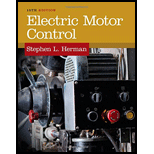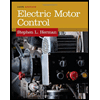
Electric Motor Control
10th Edition
ISBN: 9781133702818
Author: Herman
Publisher: CENGAGE L
expand_more
expand_more
format_list_bulleted
Concept explainers
Textbook Question
Chapter 48, Problem 1SQ
In Figure 48–2, what is the purpose of normally closed contact F?
Expert Solution & Answer
To determine
Explain the scope of normally closed (NC) contact (F) in Figure 48-2.
Explanation of Solution
Refer to Figure 48-2 in the textbook shows that plugging the motor to stop from one direction only. In this figure, the normally closed (NC) contact F is mentioned as an interlock.
In Figure 48-2, while the stop button is pressed, the forward contactor will drop out and the coil (F) is a de-energized normally closed (NC) contact F. This contact in turn, energizes coil (R) to operate the motor in the reverse direction through the closed plugging switch.
Conclusion:
Thus, the scope of normally closed (NC) contact (F) in the given figure is explained.
Want to see more full solutions like this?
Subscribe now to access step-by-step solutions to millions of textbook problems written by subject matter experts!
Students have asked these similar questions
The following circuit is at steady state for t<0. At t=0 sec, the switch is open. Let R₁ =14 ohms, R₂=14
ohms, R3-4 ohms, C₁-1 F, Vx-16 V and Ix-7 A. Find Vc1 (0.8 sec) and voltage across resistor R3 = v(1.4 sec),
as follows:
Vc1(0) in volts=
Vc1(00) in volts=
Rth in ohms=
Vc1(t-0.8 sec) in volts=
v(t-1.4 sec) in volts=
Vx
w
t=0
The relative tolerance for this problem is 10 %.
+
www
R₂
Vit
R3
+
Vc1(t)
C₁
For the circuit shown, the switch opens at t=0 sec. Find i(t=1.5) value as follows.
Let R1-12 ohm, R₂-8 ohm, L=0.6 H, V≤1-10 V and V2-8 V, and determine:
i(0) =
A
A
i(∞0) =
Rth
=
i(1.5 sec)
Ω
A
R₁
L
i(t)
VS2
R2
w
The relative tolerance for this problem is 9 %.
+
V S1
You must have noticed that, when a major appliance is turned on (such as an AC unit, garbage disposal,
etc.), your house lights dim momentarily. This is the effect of the RL circuit formed by the inductance and
resistance of the transmission line and the loads (light bulbs, appliance, etc.) In fact, even a single straight
wire has inductance. The inductance (and the resistance) of a long transmission line can be problematic if
the system is not properly designed.
The voltage on a power transmission line is alternating current but the effect of transmission line can be
simulated by a DC circuit as shown below, where R=0.005 2 /km and L=0.04 H/km representing the
resistance and inductance of the transmission line per km relationship that is with the ration: L-8 R.
In the circuit, Right =160 represents light bulb resistances, R₁ = 7
represents the resistance of a
'major appliance', and the switch indicates when the appliance is turn on.
Alice, a newly hired engineer, needs to determine…
Chapter 48 Solutions
Electric Motor Control
Ch. 48 - In Figure 482, what is the purpose of normally...Ch. 48 - Can a time-delay relay be used satisfactorily in a...Ch. 48 - Prob. 3SQCh. 48 - Prob. 4SQCh. 48 - Prob. 5SQCh. 48 - What is the purpose of the lockout relay or safety...Ch. 48 - What happens if the reverse push button is closed...Ch. 48 - Prob. 8SQCh. 48 - Prob. 9SQCh. 48 - In Figure 487, is it necessary to push the stop...
Knowledge Booster
Learn more about
Need a deep-dive on the concept behind this application? Look no further. Learn more about this topic, electrical-engineering and related others by exploring similar questions and additional content below.Similar questions
- For the circuit shown, let Let R₁-3 ohms, R2-7 ohms, C₁-2 F, VX-20 V and Ix-1 A. Calculate the capacitor voltages, as shows, at time t= (-1.3) sec and at t=1.9 sec. In particular find: V(0) = V(∞) = Rth V(t=-1.3 sec) in volts- V(t-1.9 sec) in volts- C1 HH +V(t) = - (V) (V) (S2) (V) 3 (V) Vx +1 R1 t=0 The relative tolerance for this problem is 9 %. R₂arrow_forwardIn the circuit below, the switch moves from position 1 to position 2 at t=0. Select the closest waveform which represents the inductor current: 2 R 2R V₁ t=0 0 t=0 (a) (d) t=0 (b) (e) 0 0 t=0 (c) t=0 요 (f) Note: choices are listed randomly; may not alphabetically ordered. (given during job interview question, with permission) waveform c waveform a O waveform d waveform e waveform b ○ waveform f t=0 Rarrow_forwardLet R1-8 ohms, R₂-5 ohms, L₁-2 H, Vx=10 V, in the circuit shown, to calculate the inductor current at time t= (0.6 sec) and at t= 2 sec, as follows: i(0) = 1(00) - Rth= = i(0.6 sec) = i(2 sec) = R₁ (A) (A) (N) Vx 1=0 The relative tolerance for this problem is 9 %. (A) (A) R2 ell 4₁arrow_forward
- The following circuit is at steady state for t<0. At t=0 sec, the switch opens. Let R₁=102, R₂-12 2, R3=6 2, R4-6, C=0.9 F and V₂-14 V, and find V(t) at t =2.206 sec, as follows: V(0) = (V) V(∞0) = RTh = V(2.206) = (V) (Ω) (V) {To avoid errors, and meet allowed tolerance, carry-out your intermediate numerical values as much as possible than round only the entered values to 3 significant digits} R₁ w V (+ R₂ ww + C EV(t) R3 The relative tolerance for this problem is 10 %. Question Help: Written Example I R4 www 2=0arrow_forwardPM Mon Apr 14 la800803.us.archive.org Chapter 5 Problems 199 5-8 5-9 carry generator of Fig. 5-5. Derive the two-level Boolean expression for the output carry Cs shown in the look-ahead How many unused input combinations are there in a BCD adder? 5-10 Design a combinational circuit that generated the 9's complement of a BCD digit. 5-11 Construct a 4-digit BCD adder-subtractor using four BCD adders, as shown in Fig. 5-6, and four 9's complement circuits from Problem 5-10. Use block diagrams for each compo- nent, showing only inputs and outputs. 5-12 It is necessary to design a decimal adder for two digits represented in the excess-3 code. Show that the correction after adding the two digits with a 4-bit binary adder is as fol- lows: (a) The output carry is equal to the carry from the binary adder. = (b) If the output carry 1, then add 0011. (c) If the output carry = 0, then add 1101. Construct the decimal adder with two 4-bit adders and an inverter. 5-13 Design a combinational circuit…arrow_forwardFor the circuit shown, assume the initial capacitor voltage is V(0-) = -8 V. Then at t=0, the switch closes. Find the time at which Vc(t)-8 V. Let R₁-12 S2, C1-8 F and V₂-16 V The voltage Vc(∞ )= Time-constant T= The time at which Vc(t)-8 V ist = (V) (sec) (sec) + R1 C₁ + Vct) The relative tolerance for this problem is 10 %.arrow_forward
- 13. Find i(t) for t > 0 in the following circuitarrow_forwardCalculate the Capacitor Voltage for t > 0 assuming the switch has been open for long time.arrow_forward14. Find i(t) for t > 0 in the following circuit Note: the current source is only ON for t > 0. So, it would be an open circuit for t < 0arrow_forward
- 10. Find v(t) for t > 0 in the following circuit. Note: the current source is only ON for t > 0. So, it would be an open circuit for t < 0arrow_forward3. Calculate the Capacitor Voltage for the t 0 for the following circuit. 302 292 12 V 4 V 3 F 2arrow_forward12. Find v(t) and i(t) for t > 0 in the following circuit • Note: the current source is only ON for t > 0. So, it would be an open circuit for t < 0 • Note: assume v(0) = 0V and i(0) = 0A.arrow_forward
arrow_back_ios
SEE MORE QUESTIONS
arrow_forward_ios
Recommended textbooks for you

 Electricity for Refrigeration, Heating, and Air C...Mechanical EngineeringISBN:9781337399128Author:Russell E. SmithPublisher:Cengage Learning
Electricity for Refrigeration, Heating, and Air C...Mechanical EngineeringISBN:9781337399128Author:Russell E. SmithPublisher:Cengage Learning EBK ELECTRICAL WIRING RESIDENTIALElectrical EngineeringISBN:9781337516549Author:SimmonsPublisher:CENGAGE LEARNING - CONSIGNMENT
EBK ELECTRICAL WIRING RESIDENTIALElectrical EngineeringISBN:9781337516549Author:SimmonsPublisher:CENGAGE LEARNING - CONSIGNMENT


Electricity for Refrigeration, Heating, and Air C...
Mechanical Engineering
ISBN:9781337399128
Author:Russell E. Smith
Publisher:Cengage Learning

EBK ELECTRICAL WIRING RESIDENTIAL
Electrical Engineering
ISBN:9781337516549
Author:Simmons
Publisher:CENGAGE LEARNING - CONSIGNMENT
Diodes Explained - The basics how diodes work working principle pn junction; Author: The Engineering Mindset;https://www.youtube.com/watch?v=Fwj_d3uO5g8;License: Standard Youtube License